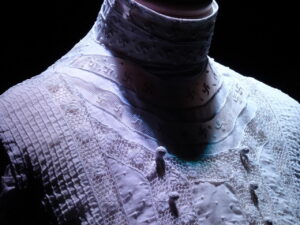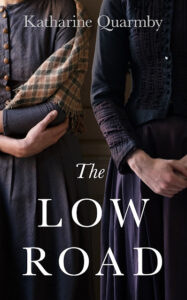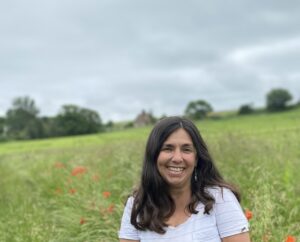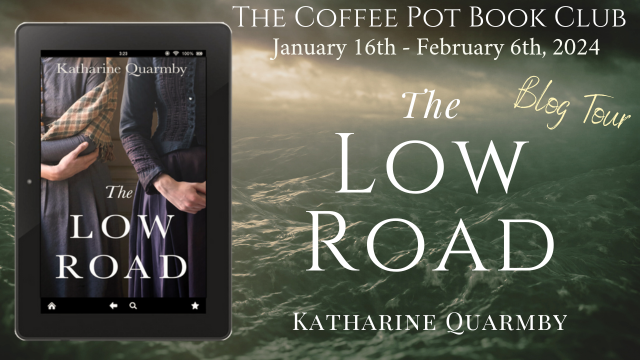Weaving Mama’s dress through The Low Road – a writer’s process
Katharine Quarmby
“The good wife had given me a grey dress, in a soft cotton, and I had hand sewn our favourite flowers around the hem, cornflowers for me, and poppies for George.”
This dress, given to the “dear mama” of the main character in The Low Road, Hannah, is woven throughout the novel. It was to have been the dress that her mother had worn to marry her father, George, but before they can wed he dies in an awful industrial accident and so, instead, it is wrapped and kept, and becomes a memory of past happiness.
It is really Hannah’s only belonging when her mother dies and she is left an orphan, in terrible circumstances. At that point, early on in the first part of the novel, Hannah has lost pretty much everything – her home on a farm where she had grown up with her mother in rural Norfolk, her only living relative to speak of, and her family’s reputation.
The local doctor and his wife, the White family, take pity on her and give her a new home in the local town of Harleston. Hannah takes one last look on the room she shared with her mother on the farm and decides to take the “the dress Mama had sewn for the wedding day that had never happened. I folded it carefully, and put it in the bundle.” She leaves her hoop, a precious toy, for she knows she has to grow up now.
Hannah’s life in rural Norfolk lasts for just four more years before she commits a very minor crime and the townsfolk decide she should leave after the kindly Mrs White dies in childbirth. After a night in the parish lock-up, she is to be sent to London with the housekeeper of an attorney in Harleston.

“Mrs Thurlow had made a space between herself and a large man, whose girth lapped me as I sat down. I shrank away from him. She passed me a small bundle. “I packed up your room for you, child. Everything is there.” Then, lowering her voice, “Your mama’s items too, her dress.” I felt the tears prickling, looked down at the bag and hugged it close”.
Mrs Thurlow takes Annie to an orphanage in London, the Refuge for the Destitute, where she is admitted as what was then called being an ‘object’. At last Hannah has security and can put the traumatic past behind her and another girl, Maria, becomes a friend. But she clings her mama’s dress and when she meets another so-called object, Annie, also convicted of stealing, they take to pilfering small objects from the Refuge’s laundry, where they are put to work, as they become closer and Maria, jealous of their friendship, withdraws. They dream of a life together.
“I loosened three floorboards below my hammock, and put together what I remembered Mama had called her trousseau. Stored against a future. With Annie. I hid the thought underneath, next to Mama’s dress, folded in paper so that each time I added an item there was a crackle.”
But Hannah and Annie’s closeness is put under threat when Hannah is sent into service. Annie is bereft, even when Hannah promises that she will come back, and they sneak upstairs together before she goes, to go through the few items they have together, hidden underneath floorboards. “so few things we have to call our own…Underneath everything is mam’s dress. I unfold it, run my finger over the flowers she had sewn, hold the fine fabric to my face. Her scent has drited away but for a moment I close my eyes and she feels nearby. I wish I could summon up her voice but it is faint now.”
Hannah does come back, as she promises, but then their life takes a turn for the worse, for Annie is to be sent into service, with the abusive family that Hannah has just left. In desperation the girls steal laundry and try to sell it, but before they can do so and leave the Refuge forever, they are arrested, sent to Newgate Prison and then convicted to transportation in the Old Bailey. Their relationship becomes frayed, and almost destroyed, by everything that they end up going through, including time in the Female Penitentiary and then on prison hulks. Even though they are pardoned, they are effectively separated by the time that they are both eventually transported, on different ships, not knowing if they will ever meet again.
Before Hannah is transported, she has a visit to her prison ship by the matron of the Penitentiary, who tries to help her and even visits the Refuge. There, her old friend Maria, takes the matron aside and gives her a small package – Hannah’s only heirloom, her mother’s dress. Mrs Martin hands it over to her, before she sails: “a package, tied up in paper and string…I knew it straight away and then I wept again.”
Hannah arrives in Sydney Cove, once called Botany Bay, in 1829. She ends up being one of the lucky ones – assigned to a decent couple, Frank and Eleanor, who is ailing. She knows that she will be safe on the farm they own, and Frank makes sure that she is set free from assignment once his wife dies, and eventually they fall in love and are to be married.
“Some days before we are to be wed, I unwrap my mama’s dress and wash it…the flowers she has embroidered are as bright as ever…and when I slip it on I find it fits me almost perfectly, outlines the curves I have, inherited from her….I am nearly the age that my mama was when she died. I will go on past her and leave her behind me, younger than I am.”
It tears after the simple wedding service, and yet Hannah finds this doesn’t matter to her anymore.
“It doesn’t matter. I have carried the dress with me across years and thousands of miles and I married him in it.”
This could have been a simple, happy ending, but Hannah could not but help look for her old friend, Annie, who she and Frank find in desperate circumstances, in a prison near Sydney. It takes months before she has started to heal from the traumas she has gone through, and there is more pain to come for Hannah as well. She has a son, called Frankie, and his birth brings back memories of everything that her dear mama had suffered.
But, towards the end, the two of them become friends again, and when it is time for Frankie’s christening, Annie offers to mend Hannah’s wedding dress, and turn it into a garment for the baby.
“She has cut the good fabric clear from the rot, and sewn a gown for the baby….saved my mama’s stitching, where she can, and woven vines around her cornflowers.”
Hannah’s story throughout The Low Road is one of pain, but also of love; it celebrates the resilience of women and their dogged ability to keep going, and to treasure the things and people that are important. The dress is one of the ways in which I explored love, loss, the fraying of bonds and the importance of repairing and mending things that were once broken.
 ABOUT THE LOW ROAD
ABOUT THE LOW ROAD

Contact Katharine
Website • Twitter • Facebook • LinkedIn • Instagram •
Amazon Author Page • Goodreads


Thank you so much for hosting Katharine Quarmby on your lovely blog today!
Take care,
Cathie xx
The Coffee Pot Book Club